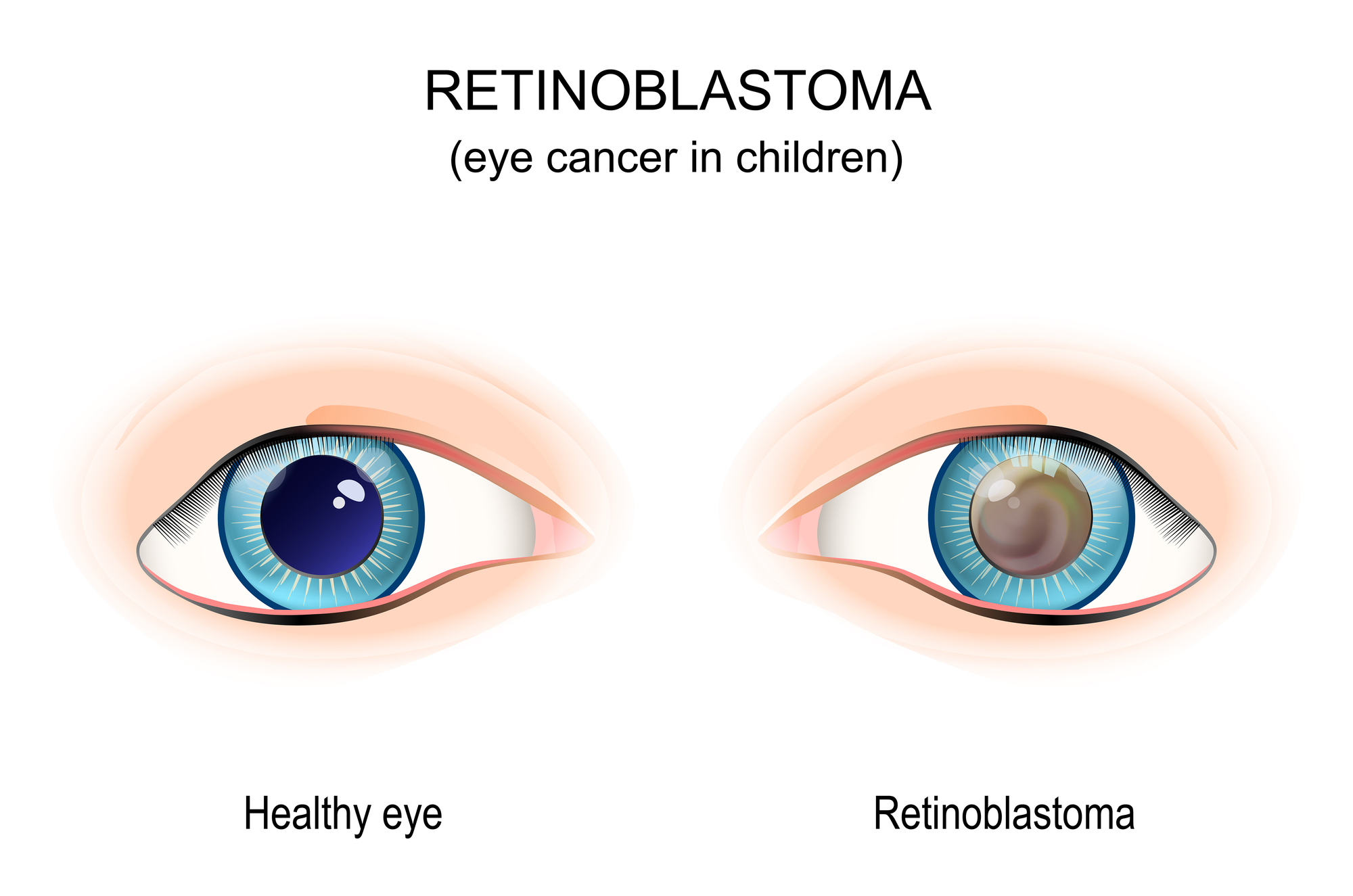Updated on April 30, 2025
Eye Cancer Symptoms, Causes, and Treatment


Vision Center is funded by our readers. We may earn commissions if you purchase something via one of our links.
Eye cancer is a rare form of cancer affecting the eyes and surrounding tissues. It can be difficult to diagnose and treat, but resources are available to help those affected by eye cancer.
There are only about 3,500 new eye cancer cases a year. This is only a fraction of the estimated 1.7 million-plus cancer cases diagnosed in the U.S. annually.1
Symptoms of Eye Cancer

The symptoms of eye cancer vary depending on the type and stage. Common signs and symptoms include:
- Blurry vision
- Eye pain or pressure
- Floaters or flashes of light in your vision
- Redness, swelling, or a lump in or around your eye
- Vision loss
- Eye irritation
- Growing dark spot on the eye's colored part (iris)
Contact an eye doctor immediately if you experience these symptoms. They can diagnose and treat the condition.
Causes and Risk Factors

The exact cause of eye cancer is unknown. However, certain factors may increase your risk of developing the condition. These include:
Age
While you can develop eye cancer at any age, the risk increases as you get older. This is because the eye cells become more susceptible to mutations as you age. The average age of diagnosis is 55.8
Exposure to UV Radiation
Exposure to ultraviolet (UV) radiation may increase your risk of developing eye cancer. These include exposure to the sun, tanning beds, or other sources of UV radiation. UV rays can damage the DNA in your eye cells, leading to mutations that can cause cancer.
Family History
In some cases, you have an increased risk of developing eye cancer due to genetics. One study says states that retinoblastoma is often hereditary and bilateral. However, uveal melanoma is rarely hereditary.9
Lighter Eye and Skin Color
People with lighter eyes and skin color are more likely to develop eye cancer. This is because lighter skin and eyes have less melanin, which helps protect against UV radiation.
Eye Cancer Statistics

Other common eye cancer statistics include:2,3
- Melanoma of the eye is more common in whites than in Blacks
- Eye cancer is slightly more common in men than in women
- The 5-year survival rate for people with eye cancer is 80%
- If eye cancer is diagnosed early, the 5-year survival rate is 85%
The American Cancer Society also has the following eye cancer statistics from 2018 to 2023:11
- For 2018, an estimated 3,540 new cases and 350 deaths
- For 2019, an estimated 3,360 new cases and 370 deaths
- For 2020, an estimated 3,400 new cases and 390 deaths
- For 2021, an estimated 3,320 new cases and 400 deaths
- For 2022, an estimated 3,360 new cases and 410 deaths
- For 2023, an estimated 3,490 new cases and 400 deaths
Types of Eye Cancer
Learning about the different types of eye cancer can help you better understand your diagnosis and treatment options.
Ocular Melanoma
Ocular melanoma is the most common type of eye cancer. It's a tumor that develops in the cells that produce melanin, which gives color to the eyes. Ocular melanoma can occur in adults and children, but it is more common in adults over 50.
It's the second most common type of melanoma after cutaneous. Ocular melanoma is also the most common primary intraocular malignant tumor in adults.6
Eye Lymphoma
Lymphoma is a type of cancer that affects the lymphatic system. Eye lymphoma is a rare type of eye cancer. When lymphoma affects the eyes, it's called primary intraocular lymphoma (PIOL) or vitreoretinal lymphoma (VRL).
It's common among people whose immune systems don't work well. Eight out of 10 people who have PIOL get it in both eyes.7
Retinoblastoma
Retinoblastoma is a rare type of eye cancer that affects children. It's a tumor that develops in the retina, the light-sensitive tissue at the back of the eye.

According to the American Cancer Society, more than 9 in 10 children with retinoblastoma are cured.8 Long-term survival is higher if the tumor has not spread outside the eye.
Secondary Intraocular Cancers
Secondary intraocular cancers spread to the eye from another part of the body. While they aren't truly eye cancers, they can still cause vision problems and other symptoms.
Secondary intraocular cancers are also more common than primary intraocular cancers. Various types of cancer can cause secondary intraocular cancers. These include:
- Breast
- Lungs
- Prostate
- Bowel
The exact cause of eye cancer is unknown. However, certain factors may increase your risk of developing the condition. These include:
Orbital Cancer
Orbital cancer occurs in the tissues around the eye. It can affect the following:
- Eyelids
- Muscles
- Nerves
- Other structures in the eye's orbit
In some cases, this type of cancer may develop when cancer cells spread from another part of the body to the eye. The outlook for orbital cancer is positive if caught early.
Early Detection and Diagnosing
The outlook for eye cancer is positive if it's caught early. Seek medical attention immediately once you experience any symptoms pointing to eye cancer.
A general practitioner can refer you to a specialist if they suspect a more serious condition. Common tests and tools used to diagnose eye cancer include:
Eye Exams
Eye exams are used to detect any changes in the eye. Your doctor may use a slit lamp microscope to look for signs of cancer. They may also ask about your medical history and family history.
Remember to be honest about any symptoms you're experiencing. This will guarantee an accurate diagnosis.
Imaging Tests
Imaging tests can help your doctor diagnose eye cancer. These tests create detailed images of the inside of your eye. They can also help determine if the cancer has spread to other body parts.
Common imaging tests include:
- Ultrasound
- Computerized Tomography (CT) scan
- Magnetic Resonance Imaging (MRI) scan
- Positron Emission Tomography (PET) scan
Biopsy
Your doctor may need to take a sample of the affected tissue. This is done through a biopsy. The sample is then sent to a lab for testing. This helps determine the type and stage of cancer.
Fluorescein Angiogram
This test uses a special dye to detect abnormal blood vessels in the eye. The dye will pass through your retina. Your doctor will then use a special camera to take pictures of your eye.10
Treating Eye Cancer
Once your doctor determines the type and stage of cancer, they can create a treatment plan. Common treatments for eye cancer include:
Surgery
Surgery is a common treatment for eye cancer. Depending on the type and stage of cancer, your doctor may recommend:
- Removal of the tumor or part of the eye
- Removal of the entire eye (enucleation)
Radiation Therapy
Radiation therapy (radiotherapy) uses high-energy beams, such as protons or gamma rays, to kill cancer cells. It can be used to shrink tumors or stop them from growing. Common types of radiotherapy for eye cancer include:
- External radiotherapy
- Internal radiotherapy (brachytherapy)
Cryotherapy
Cryotherapy is when your doctor uses extreme cold to freeze and kill cancer cells. This treatment is usually used for small tumors. During cryotherapy, your eye doctor will use a small metal probe to freeze the tumor.
Laser Therapy
Laser therapy uses a high-intensity light beam to target and destroy cancer cells. This treatment is often used for small tumors that don't respond to other treatments.
Nowadays, it's rare for laser therapy to be used for eye cancer. Side effects and a high risk of recurrence are associated with later, that's why it's not used as often.
Chemotherapy
Chemotherapy is a cancer treatment that uses drugs to kill cancer cells. It can be used to shrink tumors and stop them from growing. However, chemotherapy is not usually used to treat eye cancer.
After Treatment
Overcoming eye cancer is a tough journey. Learning how to cope with cancer's physical and emotional effects can be difficult.
After treatment, it's highly recommended to:
- Follow up with your doctor regularly. This will help ensure the cancer doesn't come back. Your doctor may recommend regular checkups, imaging tests, and blood tests
- Stay informed. Keep up with the latest research and treatments for eye cancer. Talk to your doctor about any new developments that may be relevant to you
- Maintain a strong support system. Reach out to family and friends for emotional support. You can also join a cancer support group or talk to a counselor
Prevention
Although there is no sure way to prevent eye cancer, there are some steps you can take to reduce your risk. These include:
- Wearing sunglasses and hats with a 3-inch brim when outdoors
- Using sunscreen
- Avoiding exposure to UV light
- Not smoking or using other tobacco products
- Eating a healthy diet and exercising regularly
You should also schedule regular eye exams with your doctor. This will help them detect any signs of cancer early on.
Eye Cancer Resources
If you or someone you know has been diagnosed with eye cancer, many resources are available to help. Here are some of the most helpful:
American Cancer Society
The American Cancer Society provides information about eye cancer, treatment options, and support services. They advocate for lifesaving policy changes and promote healthy lifestyles to help you prevent cancer.
Cancer Research UK
Cancer Research UK is the world's leading independent cancer charity. They also offer information on eye cancer diagnosis and treatments. They also provide resources for finding clinical trials and support groups.
National Cancer Institute
The National Cancer Institute provides eye cancer from the U.S. government's principal agency for cancer research. They guarantee that their information's accurate, up-to-date, and comprehensive.
CURE Ocular Melanoma
Community United for Research and Education (CURE) Ocular Melanoma offers support and resources for people with ocular melanoma. They provide information about eye cancer diagnosis, treatment options, and clinical trials.
Summary
Eye cancer is a rare type of cancer, but there are ways to overcome it. Various treatments and support groups are available to help you manage cancer's physical and emotional effecprets. Additionally, you can take steps to reduce your risk of developing eye cancer.
Contact your doctor immediately if you suspect you or someone you know may have eye cancer. Early diagnosis can make a huge difference in the outcome.
In this article
10 sources cited
Updated on April 30, 2025
Updated on April 30, 2025
About Our Contributors
Mara Sugue, with a B.A. in Social Sciences, is a dedicated web content writer for Vision Center. She is committed to making eye health research accessible and understandable to people from diverse backgrounds and educational levels. Her writing aims to bridge the gap between complex vision health topics and readers' needs for clear, factual information.
Dr. Melody Huang is an optometrist and freelance health writer with a passion for educating people about eye health. With her unique blend of clinical expertise and writing skills, Dr. Huang seeks to guide individuals towards healthier and happier lives. Her interests extend to Eastern medicine and integrative healthcare approaches. Outside of work, she enjoys exploring new skincare products, experimenting with food recipes, and spending time with her adopted cats.

